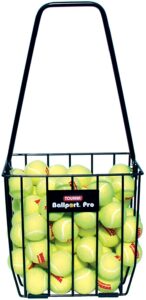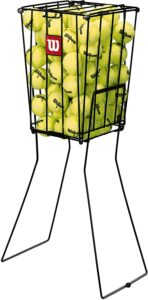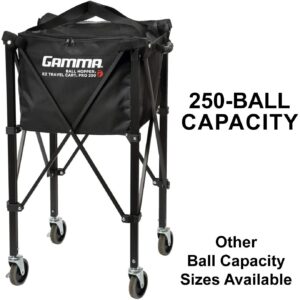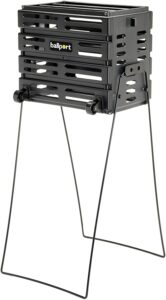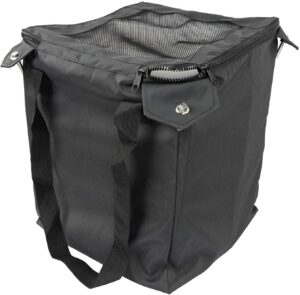If there is a must-have on a tennis court, alongside a tennis racket and ball, a tennis ball hopper is one.
It provides sufficient space for numerous tennis balls, so much so, that there are ball hoppers that hold 100 or tennis balls. Ball hoppers come in all shapes and sizes, as one might come with a lid ensuring the balls are not spilt. Every ball
hopper is typically constructed using lightweight materials, which make it much easier to transport. Additionally, some tennis ball hoppers come with caster wheels to increase mobility. You could also have a ball hopper that comes with a strap and a bag, enabling you to carry your tennis balls in a comfortable manner. Other ball hoppers have handles that have been designed to cope with the wear and tear associated with daily use. They also come in numerous sizes and are sold in a range of price points.
The aim of this article is to highlight the types of ball hoppers available for purchase, things to consider before making a purchase and of course, a review of some of the best tennis ball hoppers on the market. Let us begin!
Best Fixed Handle Hopper
If you're looking for a basic ball hopper with no extra features at all, this is your best bet. It's very inexpensive, is extremely sturdy and gets the job done.
Check Today's PriceThe Tourna Ballport Pro has an incredibly unique design that has caused it to be rated as one of the best tennis ball hoppers available on the market. The first benefit that becomes evident when you see and use this product is its durability. It has been manufactured using polypropylene, and while that might make it slightly on the heavy side, it is a sturdy material.
As a fixed handle, the handle on the 50 ball capacity ball collector has been manufactured from heavy gauge steel and is coated on a black powder anti-rust material to ensure it can withstand chips, fading and chips in any extreme weather condition. This means that this picker upper can be used for an exceptionally long time. It is capable of picking up every regulation-sized tennis balls. This includes the low compression stages 1 and 2. It is also capable of picking up the bigger stage 3 red ball.
To ensure the balls do not slide out, it has a sliding mechanism which can be seamlessly locked. Its ability to hold 50 balls might be on the small size compared to other balls, however, it does so with ease.
Tourna ensures that the parts were designed to be seamlessly and quickly assembled. When removing the ball, you simply just have to unlock the dispenser and the balls will come out one at a time, so you don’t have to worry about the balls spilling out.
Best Convertible Ball Hopper
This is the most typical style of ball hopper most people get (converts to be stand on its handles) and is our recommended buy for most people.
Check Today's PriceWilson is perhaps one of the most notable sports equipment brands, and the reason for that renown is evident with this pick up hopper. The company has over the years provided high quality products and this Wilson 90 tennis ball pick up hopper is another product that highlights that quality.
When a list of the absolute best tennis ball pick up hoppers available for purchase are mentioned, the Wilson 90 is always one on the list. With its ability to store 90 balls, it makes it one of the largest pick up hoppers on this review list. There is enough space to ensure that the hopper does not overflow, as well as ensuring tennis balls can always fit in it.
This basket has been constructed from galvanised steel ensuring that it has a great structure and is durable. When it comes to assembly, I found that it was quite easy to assemble and never really ran into any trouble.
This is a useful ball collector as it is a convertible picker upper and this means if you are interested in putting your balls in one place, this product’s handles can be transformed into legs ensuring that the basket stands upright at waist level.
Another advantage is the fact that this basket is lightweight ensuring that you can take it just about anywhere you want. Perfectly suitable for when you have to switch sides on the tennis court.
While most might believe the Wilson name would raise the price of this 90 ball pick up hopper, it is actually available at an affordable price point.
Best Plastic Convertible Hopper
At a cheaper price these plastic ball holders are a good buy for people looking for a convertible tennis ball hopper without spending much money.
Check Today's PriceThe Tourna Ballport Deluxe is a tennis caddy that is capable of picking up just about any ball of any size. One of the most significant features to set it apart from other ball collectors on this list is the fact that it comes with wheels to ensure easy maneuverability. To this end, it also has an extremely lightweight design. This is helped by the fact that it is constructed from plastic, double reinforced polypropylene, causing it to weigh 50% less than picker uppers of a similar capacity.
For its size, it is incredibly tall standing at 33 and a half inches ensuring that reaching in to get a ball is easy to do. As with other hoppers on this best tennis ball hopper list, you will have to assemble it, however, it is easy to do.
The tennis balls stored in this basket are safe thanks to a patented lock system that ensures the handles can be locked in the upright or down position. You don’t have to worry about the stands giving way underneath causing the balls to spill out of the basket.
You also get rolling and flexible bars at the bottom of the basket which enables you to pick the balls easier, even when the ball collector is full. There are also sliding bars located at the very top to ensure secure transport is quick and easy.
Best Folding Tennis Ball Cart
This is our pick for tennis instructors looking for an easy way to transport balls and to also fold up the cart when not in use.
Check Today's PriceThe Gamma EZ-Travel Cart Pro is a basket that is quite different from any other picker upper on this list. You get quite a number of features that ensure it can be placed in conversation as one of the best tennis ball hoppers available for sale. One of the features that sets this apart is the fact that it comes with locking wheels. This design is actually a great way to cart about heavy tennis balls when going from one side of the court to another. Its locking system ensures that the basket remains in place while it is being used to feed balls.
However, its portability is not simply restricted to the court. It has a nylon lining which has been reinforced with wire for additional support, making it durable and yet light enough to move around easily. The tennis balls can be safely secured thanks to a zippable top. The zip ensures that the balls do not roll out. This is perhaps one of the better ways I’ve discovered to move about a large number of balls while on the road.
To ensure that it is extremely useful regardless of the situation, Gamma has ensured the wheels can be detached. When detached, the wheels can be placed in their own carrying case, which is included during purchase. Depending on the model, you can fit anything from 150 to 250 balls. And while this capacity is advertised, it is always advised to select a comfortable carrying capacity which is generally 10 to 20 balls less than the capacity.
A great feature of this Gamma basket is its foldable design, as well as its removable handle which ensures this product can be easily stored when not in use.
Best Tennis Ball Carrier Bag
B084BTNG74
Check Today's PriceThe Get Out! Portable Tennis Ball Hopper basket is a replacement bag which offers an accessible yet efficient storage solution while you are on the court. This tennis ball bag is large enough to hold 150 tennis balls. And while a frame is not included, you are able to seamlessly store your tennis balls in it with no need to worry about if they are secure while you are on the court. The actual basket is constructed from sturdy and durable polyester ensuring that it is light yet strong enough to store your tennis balls.
This basket can be seamlessly attached to your current tennis carrier. It can also be seamlessly removed. The nylon manufactured basket comes with a zippered netting to ensure your balls do not spill out. It also comes with side straps for easy portability.
Types of Ball Hoppers
Fixed Handle Hoppers
A fixed handle tennis ball hopper is simply a small tennis cart typically constructed of light but strong wire that has a fixed handle. It looks like a larger shaped shopping cart
Convertible Hoppers
A convertible hopper looks just like a fixed handle hopper and works just the same; the bottom of the cart is pressed down onto a tennis ball and then the ball is pushed into the cart. The only difference between a fixed handle and a convertible hopper is the fact that the handles when not used can be transformed into stands for the convertible hopper.
Bag Hoppers
A bag hopper combines a tennis bag with a ball collector. It enables you to store your racket and any other accessories you might need on the tennis court, as well as pick up balls that have been misplaced over the course of a training session. Typically, the ball opening is at the bottom and you simply have to place the bag above the ball pushing down.
Tennis Ball Carts
These tennis ball carts are simply handy mobile baskets that enable you to keep the tennis balls close for seamless access. A disadvantage is that a tennis ball cart cannot pick a ball up for you. A benefit associated with using a tennis cart, however, is the fact that they are typically more durable and stable compared to all in one ball hoppers. They are also able to hold more balls.
Things to Consider
Cost
Before you purchase a tennis ball hopper, you have to ensure that it is not too expensive. This, however, does not mean you should go for the cheapest option. It is always better to select a ball hopper that is not only within your price range but is also built to last. Tennis ball hoppers can become quite expensive, so you have to factor in getting your money’s value at any price point.
Capacity
Capacity is another factor that has to be considered, as there is no point purchasing a hopper that cannot hold all the balls you use within a session. You also do not want to purchase too large a ball hopper as you have to consider the added weight of the balls. It is best to find a middle ground, one that holds about 80 to 90 balls.
Fixed Handle vs Convertible Handle
There are some tennis ball hoppers that come with handles which swivel to become legs once you are one collecting your tennis balls. This means that the balls are kept at waist level, so you don’t have to bend down to get a ball. Others come with a fixed handle that remains a handle. These ball hoppers are typically used for storage purposes.
Plastic vs Steel Wire
Tennis ball hoppers can be manufactured from either metal or plastic. Steel wire hoppers tend to provide the benefit of being sturdier, however, plastic ball hoppers are easier and lighter to carry about.
Wheels vs No Wheels
This consideration is an especially important one, especially if you plan to move your ball hopper around. Wheels can make moveability easier on you, especially when the hopper is filled with balls. Having no wheels means that you will have to move it around by hand and that could become quite a chore once the hopper is filled with balls.
FAQ
What is a tennis ball hopper for?
A tennis ball hopper is used to gather scattered balls on the court, storing them in a single place.
How does a tennis ball hopper work?
Generally, the bottom of a tennis ball hopper or a ball collector is pushed down onto a ball and rods at the bottom of the tennis ball hopper slide out of the way to give the ball entry into the hopper where it is not trapped and collected.
What are the pros and cons of filling my ball hopper with pressure-less tennis balls?
Pressureless balls, by design, are able to retain their bounce. This is because they are able to be store in places other than a vacuum. Typically, this type of storage would cause pressurized balls to lose their pressure and become flat and bounce-less. Pressure-less balls do not suffer from such a fate.
On the other hand, given that they do not have any internal pressure, they can be harder on the less resilient ball hoppers, particularly when you are pushing down on them to collect the ball.
Conclusion
If you happen to use quite a lot of balls during pay, then a ball hopper is a piece of essential equipment. A hopper of great quality can enable you to rapidly pick balls up and provide you with easy access, which then lets you spend more time playing tennis. It is important to always remember the numerous factors to consider before you buy a hopper. Things such as capacity, weight, portability and more have to be aligned with the costs.

